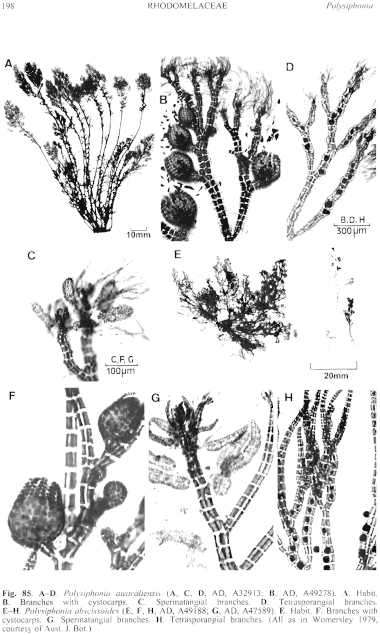|
|
|
|
|
|||||||||||
|
Electronic Flora of South Australia Species Fact Sheet
Phylum Rhodophyta – Family Rhodomelaceae – Tribe Polysiphonieae
Selected citations: Adams 1994: 319, pl. 109, upper centre. Huisman et al. 1990: 97? Kendrick et al. 1988: 204; 1990: 52. Silva et al. 1996: 536.
Synonym
Polysiphonia abscissa sensu Adams, Conway & Norris 1974: 236. [NON P. abscissa Hooker & Harvey 1845a: 266 (see under P. subtilissima).]
Thallus (Fig. 85E) dark red-brown, 4–12 cm high, densely tufted with numerous, much branched, slender, erect branches arising from prostrate filaments. Attachment by rhizoids from prostrate filaments; epilithic. Structure. Prostrate filaments (100–) 150–300 µm in diameter with segments L/D 1–1.5 (–2), with unicellular rhizoids cut off from pericentral cells; erect branches 100–175 (–200) µm in diameter with segments L/D 1.5–2 extending to 3–6 (–10) in mid parts, tapering gradually to 70–100 µm with segments L/D 1–1.5 in upper parts and (40–) 50–60 µm with segments L/D 0.5–1 near apices; apices straight to slightly curved, with fairly prominent apical cells and a few to numerous trichoblasts; lateral branches irregular and sparse but often 2–4 segments apart near apices, of limited growth and without trichoblasts; branches arising in place of trichoblasts; cicatrigenous branches absent (?) Pericentral cells 5 (occasionally 4), elongate except near apices, ecorticate throughout; trichoblasts (or scar cells) occasional in lower (older) parts, more plentiful near apices, simple or once furcate, basal cells 12–18 µm in diameter, sometimes plentiful and 2–3 times furcate in fertile plants. Rhodoplasts discoid, irregularly placed.
Reproduction: Gametophytes dioecious. Carposporophytes with a slight basal fusion cell and short gonimoblast bearing clavate terminal carposporangia 20–35 µm in diameter. Cystocarps (Fig. 85F) short-stalked, ovoid, becoming urceolate, 250–350 (–450) µm in diameter; pericarp ostiolate, 2 cells thick, outer cells isodiametric, angular. Spermatangial branches (Fig. 85G) developing as one branch of a trichoblast, cylindrical and gently tapering, (150–) 200–350 µm long and 50–75 µm in diameter, without a sterile apical cell when mature.
Tetrasporangia (Fig. 85H) forming regular, straight to gently spiral series in upper branches, often descending below 2–3 branchings, only slightly distorting the segments, subspherical, 50–75 µm in diameter.
Type from Swansea, Oyster Bay, Tas., mid eulittoral (Skinner, 22.ii.1978); holotype in AD, A49188.
Selected specimens: Bruny 1., Tas. (White, I .ii.1937; AD, A16488). Dover, Tas., low eulittoral (Wollaston, 20.viii.1965; AD, A29543 and Gordon, 14.i.1966; AD, A30006). Point Puer, Port Arthur, Tas. (Cribb 152.2, 29.vi.1951; AD, A16383 and 26.vi.1951; AD, A21024). Kangaroo Point, Derwent R., Tas. (Sullivan, Dec. 1871; MEL, 45960–2). Akaroa, N.Z., mid and lower eulittoral (Womersley, 10.x.1976; AD, A47588 and AD, A47589). Thule, Stewart 1., low eulittoral (Womersley, 5.i.1966; AD, A29902).
Distribution: Shark Bay, W. Aust? (Huisman et al. 1990, p. 97) and SE Tasmania. South I., New Zealand (see Womersley 1979, p. 493).
Taxonomic notes: P. abscissoides is the only southern Australian species of Polysiphonia consistently with 5 pericentral cells. It is characterised also by the occasional scar cell in the lower parts of the thallus, though often trichoblasts occur on every segment in fertile and actively growing plants, and by the branches arising independent of the trichoblasts. The Tasmanian plants agree well with those from New Zealand, though the latter may often be better developed. The Shark Bay record is unlikely since it is from much warmer waters than the Tasmanian and N.Z. distribution.
In habit and filament dimensions P. abscissoides is very similar to P. sertularioides but is clearly differentiated on the number of pericentral cells and the trichoblasts. P. abscissoides appears to be essentially a low intertidal species confined to the south-east coasts of Tasmania and southern New Zealand, where it has been known as P. abscissa Hooker & Harvey. The latter, however, is from South America (see under P. subtilissima) and has 4 pericentral cells and rhizoids not cut off from pericentral cells, in contrast to P. abscissoides which usually has 5 pericentral cells and the rhizoids are cut off from the pericentral cells.
References:
ADAMS, N.M. (1994). Seaweeds of New Zealand. (Cant. Univ. Press: Christchurch.)
ADAMS, N.M., CONWAY, E. & NORRIS, R.E. (1974). The marine algae of Stewart Island. A list of species. Rec. Dom. Mus. (Wellington) 8(14), 185–245.
HOOKER, J.D. & HARVEY, W.H. (1845a). Algae Antarcticae. Lund. J. But. 4, 249–276.
HUISMAN, J.M., KENDRICK, G.A., WALKER, D.I. & COUTÉ, A. (1990). The Marine Algae of Shark Bay, Western Australia. Research in Shark Bay. Report of the France-Australe Bicentenary Expedition Committee, pp. 89–100.
KENDRICK, G.A., WALKER, D.I. & McCOMB, A.J. (1988). Changes in the distribution of macro-algal epiphytes on stems of the seagrass Amphibolis antarctica along a salinity gradient in Shark Bay, Western Australia. Phycologia 27, 201–208.
KENDRICK, G.A., HUISMAN, J.M. & WALKER, D.I. (1990). Benthic macroalgae of Shark Bay, Western Australia. Bot. Mar. 33, 47–54.
SILVA, P.C., BASSON, P.W. & MOE, R.L. (1996). Catalogue of the Benthic Marine Algae of the Indian Ocean. (Univ. California Press: Berkeley.)
WOMERSLEY, H.B.S. (1979). Southern Australian species of Polysiphonia Greville (Rhodophyta). Aust. J. Bot. 27, 459–528.
The Marine Benthic Flora of Southern Australia Part IIID complete list of references.
Publication:
Womersley, H.B.S. (24 February, 2003)
The Marine Benthic Flora of Southern Australia
Rhodophyta. Part IIID. Ceramiales – Delesseriaceae, Sarcomeniaceae, Rhodomelaceae
Reproduced with permission from The Marine Benthic Flora of Southern Australia Part IIID 2003, by H.B.S. Womersley. Australian Biological Resources Study, Canberra. Copyright Commonwealth of Australia.
Illustration in Womersley Part IIIA, 2003: FIG. 85 E–H.

Figure 85 enlarge
Fig. 85. A–D. Polysiphonia australiensis (A, C, D, AD, A32913; B, AD, A49278). A. Habit. B. Branches with cystocarps. C. Spermatangial branches. D. Tetrasporangial branches. E–H. Polysiphonia abscissoides (E, F, H, AD, A49188; G, AD, A47589). E. Habit. F. Branches with cystocarps. G. Spermatangial branches. H. Tetrasporangial branches. (All as in Womersley 1979, courtesy of Aust. J. Bot.)

|
Email Contact: State Herbarium of South Australia |

|